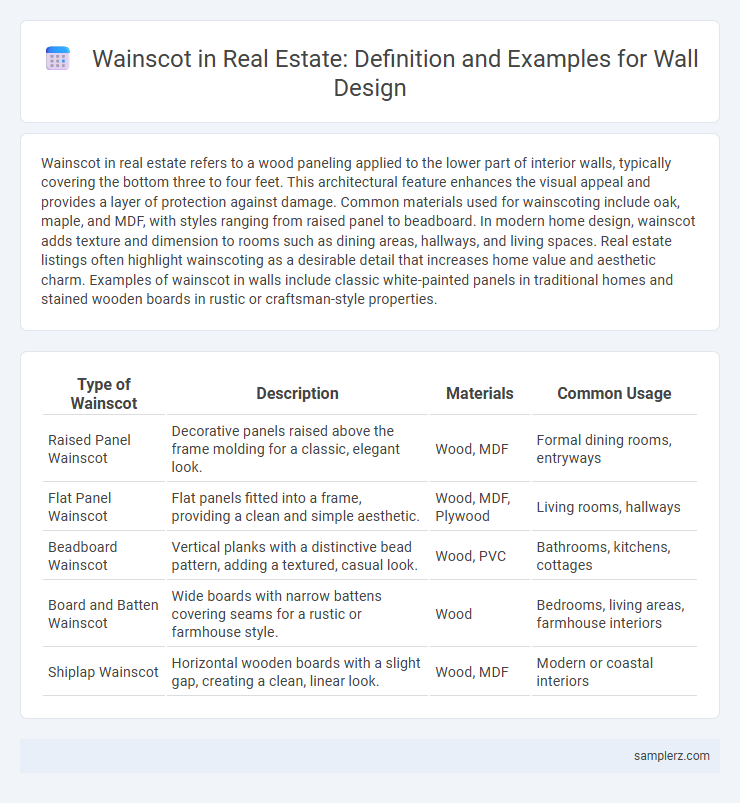Wainscot in real estate refers to a wood paneling applied to the lower part of interior walls, typically covering the bottom three to four feet. This architectural feature enhances the visual appeal and provides a layer of protection against damage. Common materials used for wainscoting include oak, maple, and MDF, with styles ranging from raised panel to beadboard. In modern home design, wainscot adds texture and dimension to rooms such as dining areas, hallways, and living spaces. Real estate listings often highlight wainscoting as a desirable detail that increases home value and aesthetic charm. Examples of wainscot in walls include classic white-painted panels in traditional homes and stained wooden boards in rustic or craftsman-style properties.
Table of Comparison
| Type of Wainscot | Description | Materials | Common Usage |
|---|---|---|---|
| Raised Panel Wainscot | Decorative panels raised above the frame molding for a classic, elegant look. | Wood, MDF | Formal dining rooms, entryways |
| Flat Panel Wainscot | Flat panels fitted into a frame, providing a clean and simple aesthetic. | Wood, MDF, Plywood | Living rooms, hallways |
| Beadboard Wainscot | Vertical planks with a distinctive bead pattern, adding a textured, casual look. | Wood, PVC | Bathrooms, kitchens, cottages |
| Board and Batten Wainscot | Wide boards with narrow battens covering seams for a rustic or farmhouse style. | Wood | Bedrooms, living areas, farmhouse interiors |
| Shiplap Wainscot | Horizontal wooden boards with a slight gap, creating a clean, linear look. | Wood, MDF | Modern or coastal interiors |
Introduction to Wainscot: Enhancing Wall Aesthetics in Real Estate
Wainscot, a decorative paneling typically installed on the lower portion of interior walls, enhances wall aesthetics by adding texture and architectural interest in real estate properties. Common materials for wainscoting include wood, MDF, and PVC, offering durability and design flexibility to complement various interior styles. Well-executed wainscot installations can increase property value by providing a refined, classic look that appeals to potential buyers and investors.
Classic Wood Panel Wainscot Examples
Classic wood panel wainscot exemplifies timeless elegance in real estate interiors, featuring raised or recessed panels crafted from hardwoods like oak, cherry, or walnut, often finished with rich stains or paints to enhance architectural detail. These wood panel wainscots typically extend up to 36 inches on walls, adding texture and warmth to living rooms, dining areas, and hallways. Incorporating crown molding and chair rails, classic wood panel wainscoting serves both decorative and practical purposes, protecting walls while elevating property value through historical charm.
Modern Wainscot Designs for Contemporary Homes
Modern wainscot designs for contemporary homes often feature sleek, minimalistic panels crafted from materials like MDF or natural wood, painted in neutral tones to complement open-concept interiors. Popular styles include flat-panel wainscoting and board-and-batten, which add texture and architectural interest while maintaining clean lines that suit modern aesthetics. Incorporating wainscot in spaces such as living rooms or hallways enhances wall durability and elevates overall design sophistication in urban residential properties.
Wainscot Applications in Living Rooms
Wainscot applications in living rooms enhance both aesthetic appeal and wall protection, typically featuring materials like wood paneling, beadboard, or MDF in heights ranging from 32 to 42 inches. These installations provide a classic or modern design accent, complementing furniture and architectural elements while preventing scuffs and dents on lower wall sections. Popular wainscot styles in living rooms include raised panel, flat panel, and board and batten, each offering unique texture and visual depth to interior spaces.
Wainscot Installations in Hallways and Entryways
Wainscot installations in hallways and entryways enhance both aesthetic appeal and wall protection, typically featuring materials like wood panels, beadboard, or MDF. These installations can range from traditional raised panel wainscoting to modern flat-panel designs, providing durability against high-traffic wear and tear. Properly installed wainscot not only adds architectural interest but also increases home value by emphasizing craftsmanship in key transitional spaces.
Wainscot Usage in Dining Room Walls
Wainscot usage in dining room walls enhances both aesthetic appeal and durability by protecting lower wall surfaces from scuffs and stains during meals. Popular materials include wood paneling, beadboard, and MDF, often painted or stained to complement dining room decor. This design element adds texture and elegance while maintaining easy maintenance in high-traffic entertaining spaces.
Bathroom Wainscot: Moisture-Resistant Options
Bathroom wainscot commonly features moisture-resistant materials such as PVC panels, fiberglass, or vinyl, which effectively prevent water damage and mold growth in high-humidity environments. These options provide both durability and an aesthetically appealing finish, enhancing bathroom walls while protecting underlying structures from moisture exposure. Installing moisture-resistant wainscot ensures long-lasting wall protection in showers, around sinks, and other wet areas commonly found in residential bathrooms.
Creative Wainscot Ideas for Bedrooms
Creative wainscot ideas for bedrooms include using beadboard panels to add a cozy, cottage-like texture or installing shaker-style wood panels for a classic, timeless look. Combining painted wainscoting with wallpaper above creates a striking contrast, enhancing the room's visual depth and character. Incorporating built-in shelves within the wainscot design maximizes storage while maintaining elegant wall detailing.
Wainscot Materials: Wood, MDF, and Alternatives
Wainscot materials commonly include natural wood, such as oak or maple, providing durability and a classic aesthetic often favored in high-end real estate interiors. Medium Density Fiberboard (MDF) serves as a cost-effective alternative, offering smooth surfaces ideal for painting and intricate designs without the expense of solid wood. Other alternatives like PVC and vinyl wainscoting deliver moisture resistance and easy maintenance, making them popular choices for bathrooms and basements in residential properties.
Wainscot Installation: Key Benefits for Property Value
Wainscot installation enhances interior walls by adding a durable, decorative paneling that protects against scuffs and moisture damage, making it ideal for high-traffic areas. This feature not only improves aesthetic appeal with elegant textures and finishes but also increases property value by signaling quality craftsmanship and attention to detail. Homebuyers and renters often perceive wainscot as a sign of well-maintained, upscale spaces, thereby boosting marketability and resale potential.

example of wainscot in wall Infographic
 samplerz.com
samplerz.com